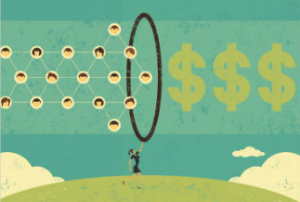 Crowdfunding is disrupting the relationship between entrepreneurs, the money raising ecosystem and investors. Kickstarter, Indiegogo and other sites are helping innovators to build businesses and leverage funding with more than 200 online crowdfunding platforms in the U.S. alone.
Crowdfunding is disrupting the relationship between entrepreneurs, the money raising ecosystem and investors. Kickstarter, Indiegogo and other sites are helping innovators to build businesses and leverage funding with more than 200 online crowdfunding platforms in the U.S. alone.
Evidence is mounting that crowdfunding is starting to impinge on the seed turf of angel investors. Venture capitalists (VC) are no longer immune from the effects of crowdfunding, as feal making within a crowd context is leveling the playing field with terms that are more favorable to entrepreneurs. This is especially ture on the East Coast where words like ‘dividends’ and ‘participating preferred terms’ permeate most term sheets. Crowdfunding also increases a company’s potential valuation, and adds competition to a VC round.
Until now, private equity investments have worked against the interests of entrepreneurs, particularly first-timers. Crowdfunding opens a brand new avenue. It’s an increasingly common way for entrepreneurs, new business owners, artists and creators to finance their projects, many in categories where funding might be challenging.
John Biggs, a tech writer and editor of TechCrunch launched a campaign on Idiegogo for Mytro, his novel written for young adults. “It’s the story of a secret subway that runs underneath the world’s capitals, the kids who discover it, and the strange and dangerous group bent on taking control of it,” Biggs wrote.
“I’ve never taken part in a crowdfunding effort. With your help, we can talk about some of the problems facing publishing today and I hope to write a series of articles about my experience as I go from author to publisher in one fell swoop,” he added.
His approach provides an anatomy of a successful campaign. At first, he set out to raise $10,000 and promised to sign every hardback edition. Once he accomplished this, he raised the goal to $15,000, and then set an $18,000 “stretch goal,” promising investors would get a 3D-printed rail car. If Mytro fundraising efforts reached $20,000, every paperback buyer would receive a 3D-printed Mytro car. Potential investors could learn about the Mytro campaign on his blog, as well as on Facebook and Twitter.
Another crowdfunding success took place at SXSW, where Veronica Mars sprung back to life. It was a triumphant mix of Hollywood and crowdsourcing. Fans of Kristen Bell’s previous TV show, aided by Kickstarter, helped fund a movie version, in conjunction with Warner Bros.
Engaging Investors
Other projects posted on Indiegogo, Kickstarter or community investment fundraising efforts, verge on marketing brilliance. Crowdfunding backers are highly engaged, and are not just warm leads gathered via a landing page. It allows entrepreneurs to directly connect with their supporters and prospects. Once these backers become financially invested, they also become an entrepreneur’s advocates and help to generate buzz, since as an “investor” there is a sense of ownership that is rarely achieved by other marketing tactics.
We’re now also hearing about companies that may not need funding, but are using the Indiegogo and Kickstarter platforms as a marketing tactic to build community and advocacy prior to launching a product or service. It may be a way for even established companies to create a valuable community of early adopters and some extra buzz.
Crowdfunding and other socially engaging platforms are giving innovators and game-changers new opportunities beyond just bootstrapping or VC/angel funding.
Keep the conversation going at susan at c4trends (dot) com

